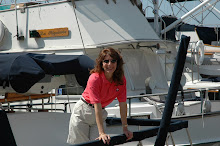VIEW FROM THE MARINA: If It's Brown, You're Aground
View from the Marina
If It’s Brown, You’re Aground
By Barb Hansen
April 1, 2005
Hundreds of books are available to us about how to be better boaters. But in my book even the very best nautical tome, Chapman’s Piloting, Seamanship and Small Boat Handling, places a distant second to learning on the vessel with the help of an experienced captain.
Speaking as the proprietor of a live-aboard yacht school – Okay, twist my arm: Florida Sailing & Cruising School – this kind of learning operates on at least three levels. You’re seeing it. You’re doing it. You’re having fun. Compare that to burning the midnight oil to cram for the final. The old saw is true: Tell me, I forget. Show me, I remember. Involve me, I understand.
I know, I know, book learning is a wonderful thing. I’ll be the first to say the printing press lifted western civilization out of the dark ages and taught us about everything from Greek philosophy to Madonna’s sex life. But even if you have memorized Chapman’s Piloting from page 6 to page 636, you haven’t heard our Captain Gary Graham calmly talking you and your trawler safely through a tight spot.
Negotiating the skinny channel between Pine Island and the Florida mainland, you probably would have heard Captain Gary say, “If it’s blue, sail on through; if it’s brown, you’ll run aground. You didn’t read that in Chapman.
Let’s say you’re up on the fly bridge and your assignment as the student is to park this yacht with a 12-foot beam in a 12-foot slip. There’s wind. (Of course) You’re facing astern with your hands on the gears and throttles. Engines are throbbing, as is your heart, which is in your throat. At this point the instructor, Captain Greg Corsones, puts it all in the perspective of experience. Says he, “Only go as fast you want to hit something.”
Right on.
Captain Bob Mahood jives up his sailing course with a reminder to skippers to “keep the slimy side down.” Anybody who has cruised the skinny-water bays of Southwest Florida has seen our egrets and herons walking on water. Says Bob, “Don’t sail where birds walk.”
Captain Greg reminds his students, “Boats have neutral for a reason. If you don’t know where you’re going, don’t go.” I like his observation about other boaters seen breaking the rules of the road: “Seldom right, but never in doubt.”
“When’s the best time to reef your sails,” a student asks. “The first time you think you should,” answers Capt. Graham.
My Vic gets off a couple of good ones in his lectures. “If you run aground, have a drink!” That’s his shorthand for telling skippers what to do (or, rather, what not to do) if they should run aground.
First make sure the boat is not sinking. Shut down the engines and go to the fridge for something cold to drink. Kick back and assess the situation. He tells the story of the skipper who ran up on a sand bar. All he had to do is wait for the tide to come in. But, in a panic to do something he put the engines in reverse gear and promptly tore up two prop shafts.” The physician’s code works for boaters, too. First, do no harm.
Once upon a time the proprietor of a certain yacht school and her husband ran up on an Everglades mud flat and put their vessel on its side. Eventually the tide came back in and floated the vessel again. Periodically, Vic and I will remind each other of that learning experience. Embarrassment is better than expensive. And you never forget embarrassment.

